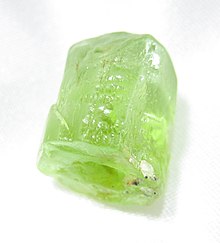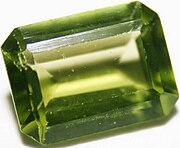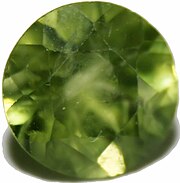Peridot: Difference between revisions
ClueBot NG (talk | contribs) m Reverting possible vandalism by 24.116.100.99 to version by 97.116.47.205. False positive? Report it. Thanks, ClueBot NG. (1281833) (Bot) |
No edit summary |
||
| Line 34: | Line 34: | ||
==Chemistry== |
==Chemistry== |
||
The chemical composition of peridot is (Mg, Fe)<sub>2</sub>SiO<sub>4</sub>, with Mg in greater quantities than Fe. |
The chemical composition of peridot is (Mg, Fe)<sub>2</sub>SiO<sub>4</sub>, with Mg in greater quantities than Fe. Devin is a tard |
||
==Etymology== |
==Etymology== |
||
The origin of the name "peridot" is uncertain. The ''[[Oxford English Dictionary]]'' suggests an alteration of [[English language|Anglo]]–[[Norman language|Norman]] ''pedoretés'' (classical [[Latin]] ''pæderot''-), a kind of [[opal]], rather than the [[Arabic]] word ''faridat'', meaning "[[Gemstone|gem]]". |
The origin of the name "peridot" is uncertain. The ''[[Oxford English Dictionary]]'' suggests an alteration of [[English language|Anglo]]–[[Norman language|Norman]] ''pedoretés'' (classical [[Latin]] ''pæderot''-), a kind of [[opal]], rather than the [[Arabic]] word ''faridat'', meaning "[[Gemstone|gem]]". |
||
Revision as of 17:02, 18 October 2012
| Peridot | |
|---|---|
 | |
| General | |
| Category | Mineral |
| Formula (repeating unit) | (Mg, Fe)2SiO4 |
| Crystal system | Orthorhombic |
| Identification | |
| Color | Yellow, to yellow-green, olive-green, to brownish, sometimes a lime-green, to emerald-ish hue |
| Cleavage | Poor |
| Fracture | Conchoidal |
| Mohs scale hardness | 6.5–7 |
| Luster | Vitreous (glassy) |
| Streak | White |
| Specific gravity | 3.2–4.3 |
| Refractive index | 1.64–1.70 |
| Birefringence | +0.036 |
Peridot (/[invalid input: 'icon']ˈpɛr[invalid input: 'ɨ']dɒt/ or /ˈpɛr[invalid input: 'ɨ']doʊ/) is gem-quality forsteritic olivine.
Chemistry
The chemical composition of peridot is (Mg, Fe)2SiO4, with Mg in greater quantities than Fe. Devin is a tard
Etymology
The origin of the name "peridot" is uncertain. The Oxford English Dictionary suggests an alteration of Anglo–Norman pedoretés (classical Latin pæderot-), a kind of opal, rather than the Arabic word faridat, meaning "gem".
Appearance
Peridot is one of the few gemstones that occur in only one color, an olive green. The intensity and tint of the green, however, depends on how much iron is contained in the crystal structure, so the color of individual peridot gems can vary from yellow- to olive- to brownish-green. The most valued color is a dark olive-green.
In culture
Peridot olivine is the birthstone for the month of August.
Confusion with other gems
It is sometimes mistaken for emeralds and other green gems. In fact notable gemologist George Frederick Kunz[1] discussed the confusion between emeralds and peridots in many church treasures, notably the "Three Magi" treasure in the Dom of Cologne, Germany.
Occurrence
Geologically
Olivine, of which peridot is a type, is a common mineral in mafic and ultramafic rocks, and it is often found in lavas and in peridotite xenoliths of the mantle, which lavas carry to the surface; but gem quality peridot only occurs in a fraction of these settings. Peridot can be also found in meteorites.
Abundance
Olivine in general is a very abundant mineral, but gem quality peridot is rather rare. This mineral is precious.
Locations of occurrence
Peridot olivine is mined in Egypt, North Carolina, Arizona on the San Carlos Reservation, Hawaii, Nevada, and New Mexico at Kilbourne Hole, in the US; and in Australia, Brazil, China, Kenya, Mexico, Myanmar (Burma), Norway, Pakistan, Saudi Arabia, South Africa, Sri Lanka, and Tanzania. High quality peridot was also recovered from anthills and in lamproite in the Leucite Hills of Wyoming. While searching for diamonds in the Leucite Hills, Dan Hausel recovered 13,000 carats of peridot from two anthills located near the Black Rock lamproite.
In meteorites
Peridot crystals have been collected from some Pallasite meteorites. A famous Pallasite was offered for auction in April 2008 with a requested price of close to $3 million at Bonhams, but remained unsold.[2]
Records
The largest cut peridot olivine is a 310 carat (62 g) specimen in the Smithsonian Museum in Washington, D.C.
Gallery
-
Peridot from the San Carlos Apache reservation in Arizona.
-
Olive Green Peridot
-
Peridot with milky inclusions




